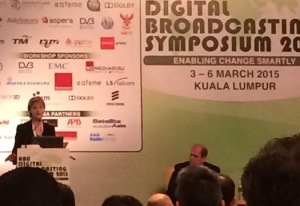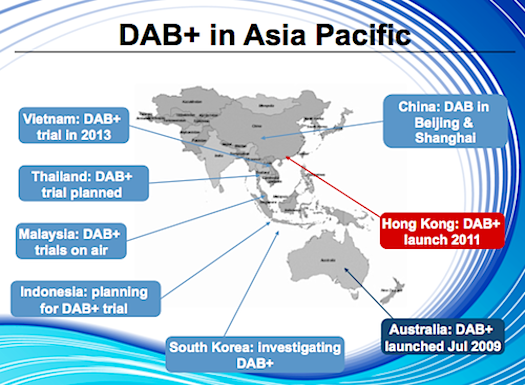Radio needs to give tech savvy consumers in Asia new ways to connect and interact.
Digital Radio can help broadcasters achieve that, according to the Asia PacifIc Chair of WorldDMB and Commercial Radio Australia CEO Joan Warner.
She gave this keynote speech to the Digital Broadcasting Symposium in Kuala Lumpur, Malaysia last week.
How Asia Pacific Adoption of DAB+ can drive Innovation
Radio is still one of the most influential, most loved and most used of media in this region.
Radio is often forgotten or overlooked and we are sometimes so bedazzled by the glamour of new media that we forget the very real and important role broadcast radio plays in the lives of tens of millions of people every day.
The radio industry in the Asia Pacific region is a healthy and growing part of the media sector.
There are many well respected public service radio stations already in the region and, in some jurisdictions, growing and vibrant new and not so new private radio broadcasters – all adding to diversity.
Asia is the world’s largest and most populous region with a dynamic radio industry offering a wide variety of radio stations, in a multitude of languages.
Predicted growth figures for the region, indicate there will be 2 billion people living in Asian cities in just 10 years in 2025 – and 3 billion in cities by 2050 – double the current level.
I know I’m not telling you anything you don’t already know but, with population growth comes demand for energy efficiencies and for finding new ways of meeting consumer demand for more and better information.
DAB+ broadcast technology can be key here. There is no reason for radio broadcasters to accept that they should remain forever in a limited analogue environment when every other medium is moving to digital.
And as I’ve said many times, mobile networks simply cannot provide a robust, high quality, free to air alternative to radio’s broadcast power.
I often relate how my mobile phone drops out as i drive to work in Australia’s biggest city – sometimes simply because a large truck drives by or I pass a tree or a building ….
Streaming does have a place in radio’s future but not as a replacement for the reliability and robustness of broadcast in delivering vital news, information etc to massive audiences live at the same time.
Broadcasters cannot afford to trust their future and their audiences to a less reliable, less robust platform and put at risk the rights of millions of people to easy to access, live, local, high quality content – that via broadcast does not use up a data allowance or put unnecessary strain on the battery of a mobile device as streaming does.
DAB+ broadcast technology is free to receive and is, long term, more cost efficient for broadcasters. It uses less power and takes up less space and assists governments in making best use of limited spectrum.
One DAB+ Mux can host many stations. These costs can be shared and energy and equipment bills reduced.
Adoption of DAB+ in the Asia Pacific would drive even more innovation in DAB+.
A number of economies in the Asian region are shifting to high skill jobs while maintaining a relatively low wage structure.
The adoption of DAB+ would drive the demand for a diverse range of receivers across multiple platforms – stand alone radio, car radios and in phones.
As you already know, DAB+ has already hundreds of receivers available now from as little as AUD $17 (10 Euros) and with Asia Pacific advances in adoption these prices should tumble even further
Urbanised populations made up of young working aged people demand the latest technology, more goods and services, more food, more entertainment, more education, and all at low cost and in a mobile environment.
In order to meet the demands of these growing tech savvy populations, radio needs to give them more –
more content, more choice, more interactivity, at the lowest cost possible. Which is exactly what DAB+ can provide.
Interest in DAB+ in the region is high.
DAB+ is fast becoming a global digital radio standard and manufacturing hub countries from the Asia Pacific have been traveling to Europe, and Australia to investigate DAB+ digital radio regulatory frameworks and operations, in preparation for their country’s trials and/or adoption of the DAB+ standard.
One prime example is Korea. Korean adoption of DAB+ would help encourage high profile world wide smartphone brands such as LG and Samsung in Korea to support DAB+ digital radio.
With nearly 2.5 billion of the world’s 4.3 billion mobile phone users in the Asia-Pacific – a share that’s expected to increase with the ongoing population growth – a DAB+ chip could continue the innovation in hybrid radio, where links can be broadcast free to air via DAB+ and a smartphone backchannel provides users with interactivity.

Just a very brief overview of positive developments re radio digital broadcasting in the region:
In Thailand NBTC is working with the ITU to model the phasing and costs of rolling out DAB+ digital radio in Thailand.
Thailand is actively working toward a large scale DAB+ trial in 2015.
Indonesia’s national broadcaster, RRI, became a new member of WorldDMB and, at the end of last year, RRI and the regulator MCIT held a private technical workshopto advance their planning for expansion of the jakarta DAB+ trial.
Here in Malaysia the Malaysian national broadcaster, RTM, hosted a WorldDMB workshop and drive tests last year. The regulator is supportive and the local digital radio committee is preparing a report with recommendations for next steps and the future.
In Vietnam, the new technical director of VOV held a follow up digital radio workshop in Vietnam in October 2014 which was attended by several WorldDMB members.
In Australia, DAB+ is in the five major cities and two trial cities and already provides 64% population coverage.
Reception continues to improve with 11 low cost repeaters licenced and built this year.
Over 2m DAB+ digital radio devices have been sold and three million people listen to free to air radio each week on DAB+ radios. 23% of all radio listening in the five capital cities is on a DAB+ device.
It is interesting to note that in just 5 years, listening to radio via broadcast DAB+ has outstripped listening to radio via streaming by more than 1.3 million more people each week.
The Australian radio industry has asked that the federal government establish a digital radio industry planning committee to work on a timetable for phased rollout of DAB+ services outside of the 5 major cities and to reconfirm the previous allocation of a large block of vhf band 3 Specturm in regions for this purpose.
We are hoping for a response soon and have had some positive indications that this may happen in the near future.
The DAB family of standards has the largest number of digital radio receivers on the market – hundreds in fact – all readily available across a number of markets in a diverse range of styles and designs so listeners can access DAB+ radio where ever and whenever they desire.
They are available in a range of prices from the very afforDABle – as noted earlier – to the high end receivers and more with an interactive screen.
Chip-manufacturers are working on increasing penetration of DAB/ DAB+/DMB chips in more devices such as mobiles and tablets.
Receiver manufacturers are focusing on bringing digital radio to the consumer in a more engaging manner through the interactive screen.
Adoption of DAB+ in the region would open up the mass market that the manufacturers are looking for, to drive the ongoing innovation in receivers.
One of WorldDMB’s key focuses in this next 12 months is working with handset manufacturers to make free broadcast DAB+ available in smartphones – this is the next big step up for the technology.
WorldDMB also works closely with vehicle manufacturers from around the world.
A large percentage of radio listening around the world is done in the car and it seems we’re spending more and more time in the car as traffic congestion gets worse.
In Australia alone, in-car radio listening has risen from 21% 12 years ago to 34% in terms of place of listening Nearly 30 vehicle manufacturers world wide include DAB+ digital radio.
The growing middle class consumer in this region will drive demand in vehicle sales.
A Nielsen global study last year reported vehicle purchase intent is high in Indonesia, Philippines, Thailand and Malaysia, all ranking in the top 10 countries globally for intention to acquire a car within the next two years.
Around four in five Indonesian and Thai consumers (81% and 79% respectively) intend to acquire a car within the next two years, as do seven out of 10 Malaysians (71%), compared to just 65 percent globally.
The same survey said 3 out of 10 Malaysian consumers spent more than an hour driving to work. Prime time for radio listening!
Vehicles with DAB+ digital radio will continue to grow… WorldDMB is working globally and in individual markets.
In summary – the Asia Pacific region is incredibly important to the continued success and innovation of DAB+ digital
radio and to the future of broadcasting in general.
This region has growth in population, demand for energy efficiency, and tech savvy populations that want more out of their entertainment but at little or no cost.
DAB+ digital radio gives radio broadcasters a chance to move to the next stage of development.
Spectrum is key and broadcasters need to signal intentions to governments now to make sure they have a digital broadcast future – one that ensures that innovation in radio continues to allow radio to serve our hundreds of millions of listeners.
Funding and consistent political leadership will drive the adoption and we look forward to ongoing development in the region.
But once again, broadcasters need to work with government to make it happen.
In ending, I am happy to announce that WorldDMB is willing to offer whatever help, advice and support broadcasters and regulators may need to move radio forward and ensure its future in a digital world.
To that end broadcasters and regulators in Asia Pacific countries actively exploring, trialling and moving towards a DAB+ broadcast future will be invited to a high level policy and regulatory think tank to be hosted by WorldDMB in this region in the next 12 months.
We will ask for senior decision makers to attend so we can, together, examine any roadblocks and work out, together, solutions for the next steps to make DAB+ a reality.
Ultimately we will am to cut costs for broadcasters, make best use of spectrum for governments and importantly continue to bring to hundreds of millions of listeners the free to air information, entertainment, sports, news, weather, and emergency information with the reliability and robustness that listeners across the Asia Pacific expect and deserve.
As broadcasters we need to determine our own future and not let others take it from us.

